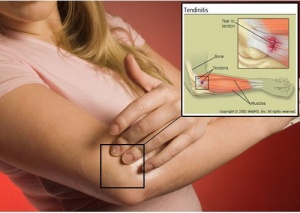How to Improve the Symptoms of Tendonitis

It can be a painful condition, but with the right treatment and some helpful tips we’ll discuss in this article, you can improve the symptoms of tendonitis and lead a normal and happy life.
Tendonitis is a condition that occurs when the tendons become inflamed. It mainly happens to the tendons of the heels and biceps. Their size increases and they become swollen.
The main cause of this condition is a repetitive movement while using poor posture, or pressure from footwear. Basically, it is usually due to an incident that causes the tendon to become inflamed. However, any strain or trauma as a result of working your muscle incorrectly can cause tendonitis in the long term.
About tendonitis
The first signs of this condition is experiencing tendon pain when you move or apply pressure to the area. Having a hard time moving your joints is another common symptom.
The best way to improve the symptoms of tendonitis is by resting or not moving the part that hurts. You can keep it still by using a stint. You should also use different footwear if you experience any problems in your Achilles tendon (which is the tendon in your heel).

Tendonitis is mainly treated by reducing the pain and inflammation. If it is a really bad case, you may want to try a topical anti-inflammatory gel or cream that you put directly on the surface where the swollen tendon is.
You should try to not move the affected tendon very much and directly apply heat or cold to help ease the pain. Keep in mind that if you have a progressive case of tendonitis, it can wear away the tendon and cause damage that won’t heal fully. Even so, there are many natural ways to improve the symptoms of tendonitis and ease the pain.
Suggestions to ease pain
- Changing how you exercise is the first thing you can try when you suffer from tendonitis. You should not practice any sports that overwork the affected area. You can instead replace them with more relaxing exercises, such as yoga, which may help reduce the pain, yet keep you active while you rest the inflamed tendon.
- As we previously mentioned, you can also apply heat or cold to the area to help ease the pain. You should do this in 20 minute increments. This means that you should apply heat or cold for 20 minutes, and remove it for 20 minutes. Repeat this using a bag of ice or hot compress until the pain goes away.
- Fish oil supplements or an increased fish oil intake is also another helpful suggestion since it increases Omega 3 and natural anti-inflammatory agents in the body. This helps eliminate the inflammation you experience when you have tendonitis.
- Rest is the best recommendation for anyone who has tendonitis. Sleeping 8 hours a night helps accelerate the natural healing process of the tendon.
Also read:
5 Things Fish Oil Can Do For You
Natural recipes to improve the symptoms of tendonitis

There are also some natural, plant-based recipes that can help improve the symptoms of tendonitis. These plants have properties that relax and reduce muscle inflammation which helps ease pain. A couple of these plants are:
- Willow, which shares some of the characteristics of aspirin. It’s helpful in treating the symptoms of tendinitis. You can make a syrup using two grams of the dry bark in one glass of water and drink it two or three times a day. However, you really shouldn’t drink it for extended periods of time, since it can upset the digestive system.
- Echinacea is a plant with some powerful anti-inflammatory properties. You can drink it in the form of an herbal tea adding one spoonful of this plant to one cup of water. Drink one or two cups a day.
We recommend:
Finally, it’s really important to eat foods rich in magnesium, which binds together the damaged ligaments. Some good foods to eat would be lettuce, parsley, asparagus, spinach, and nuts.
You can prevent this condition by limiting activities that require an excessive amount of strength, improving your diet, and doing relaxing exercises to rest the muscles and tendons. Tendonitis is an avoidable and treatable nightmare if you care about your health.
All cited sources were thoroughly reviewed by our team to ensure their quality, reliability, currency, and validity. The bibliography of this article was considered reliable and of academic or scientific accuracy.
- Aarland, R. C., Bañuelos-Hernández, A. E., Fragoso-Serrano, M., Sierra-Palacios, E. D. C., Díaz de León-Sánchez, F., Pérez-Flores, L. J., … & Mendoza-Espinoza, J. A. (2017). Studies on phytochemical, antioxidant, anti-inflammatory, hypoglycaemic and antiproliferative activities of Echinacea purpurea and Echinacea angustifolia extracts. Pharmaceutical biology, 55(1), 649-656. Available at: https://doi.org/10.1080/13880209.2016.1265989. Accessed 10/03/2020.
- Bonaterra, G. A., Heinrich, E. U., Kelber, O., Weiser, D., Metz, J., & Kinscherf, R. (2010). Anti-inflammatory effects of the willow bark extract STW 33-I (Proaktiv®) in LPS-activated human monocytes and differentiated macrophages. Phytomedicine, 17(14), 1106-1113. Available at: https://doi.org/10.1016/j.phymed.2010.03.022. Accessed 10/03/2020.
- Mayo Clinic (2019). Tendinitis de Aquiles: diagnóstico y tratamiento. Available at: https://www.mayoclinic.org/es-es/diseases-conditions/achilles-tendinitis/diagnosis-treatment/drc-20369025. Accessed 10/03/2020.
- Wall, R., Ross, R. P., Fitzgerald, G. F., & Stanton, C. (2010). Fatty acids from fish: the anti-inflammatory potential of long-chain omega-3 fatty acids. Nutrition reviews, 68(5), 280-289. Available at: https://doi.org/10.1111/j.1753-4887.2010.00287.x. Accessed 10/03/2020.
This text is provided for informational purposes only and does not replace consultation with a professional. If in doubt, consult your specialist.








